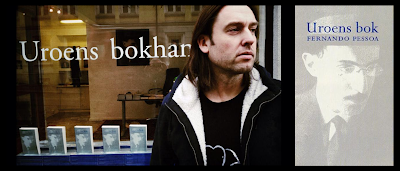Este Natal levámos
a Noruega a Portugal. E não foi só no bacalhau. Também comemos pinnekjøtt (comeram o quê???? Pinnekjøtt!). O pinnekjøtt é um dos pratos tradicionais para o dia de Consoada na
Noruega. Mas no dia 23 também caiu muito bem, posso-vos dizer.
A carne é de
cordeiro, salgada, e, tal e qual bacalhau, precisa de ser demolhada durante um
ou dois dias. Levamo-la da Noruega. Depois de cozinhada, tem um sabor muito
forte (mas bom!). Para acompanhar, comemos salsichas, batatas cozidas e puré de
um vegetal chamado kålrabi (não sei a
tradução para português, nem sequer sei se temos. Mas é uma espécie de nabo
amarelo por dentro)
O nome
significa pinne = pauzinhos + kjøtt = carne, porque a carne é cozinhada
em cima de pauzinhos. É super fácil de fazer, mas demoooooora… (contem bem com
três horas!) …e cheeeeira…
Ingredientes:
~400g de carne
por pessoa (grande parte disto é só osso)
pauzinhos
água
salsichas
batatas para
cozer
o tal kålrabi
cenouras
um pacote de
natas para chantilly
manteiga
noz-moscada,
pimenta e sal
Preparação:
1. Demolhar a carne em água durante
mais ou menos 30 horas.
2. No fundo de uma panela larga,
colocar os pauzinhos em grelha e adicionar água até cobri-los.
3. Colocar a carne por cima e tapar.
Deixar cozinhar a vapor, em lume brando, por aproximadamente 3h. Estará pronto
quando a carne sair facilmente do osso.
4. As batatas e as salsichas, cortadas
em pedaços grandes, podem ser adicionadas nos 15-20 minutos finais para cozerem
com a carne.
5. Entretanto, fazer o puré de kålrabi: cozer o dito com uma cenoura
grande e uma batata. Passar tudo com a varinha mágica. Envolver nas natas,
adicionar manteiga, noz-moscada, pimenta e sal a gosto.
6. Não esquecer de servir o molho que
fica na panela depois de a carne ter cozinhado a vapor. É basicamente água e
gordura.
7. Feito!
Ah, e não
esquecer o aquavit e cerveja de Natal a acompanhar! E
tirando esta parte… o estômago da Bacalhau agradece!
- - - - -
This Christmas
we took a little bit of Norway to Portugal. Not only with the cod fish. We have
also eaten pinnekjøtt (have you eaten
what???? Pinnekjøtt!). Pinnekjøtt is one of the traditional
dishes on Christmas’ Eve in Norway. But it tastes equally well on the 23rd of
December, I have to say.
Pinnekjøtt is
ribs from lamb that have been salted, and sometimes also smoked, to preserve
it. We brought it from Norway. As cod fish, it needs to be soaked in water for
1 or 2 days to remove most of the salt. After cooking, the meet has na intense (but
delicious!) taste. It is eaten with sausages, boiled potatoes and swede (a.k.a.
rutabaga) puree.
Directly
translated, pinnekjøtt means pinne = sticks + kjøtt = meat, since the meat is cooked on the top of birch sticks.
It’s very easy to make, but it also requires some time… (count on around 3h)
…and it smeeeeels…
Ingredients:
~400g of meat
per person (most of this is bone)
birch sticks
water
sausages
potatoes to
boil
one of that swede/rutabaga
thing
carrots
cream
butter
nutmeg, salt
and pepper
Preparation:
1. Soak the meat in water for aroud 30
hours.
2. Build a grid in the bottom of a
large pot by criss-crossing layers of sticks. Fill water to the top of the
grid.
3. Place the meat on top and cover with
a lid. Let it steam at low heat for approximately 3 hours. It will be done when
the meat falls easily off the bone.
4. Big pieces of potatoes and sausages
can be added to the pot for the last 15-20 minutes to cook together with the
meat.
5. Meanwhile, make the swede/rutabaga
puree: boil it in pieces with a big carrot and a potatoe. Mash by hand. Add
cream add butter and give it a good stir. Add nutmeg, salt and pepper as you
like.
6. Don’t forget to serve the sauce left
in the pot after the cooking of the meat Basically, it is only water and fat.
7. Done!
Oh, and don’t
forget a shot of aquavit and a glass of Christmas beer! Besides this part… the stomach of Bacalhau says thanks to pinnekjøtt!
























